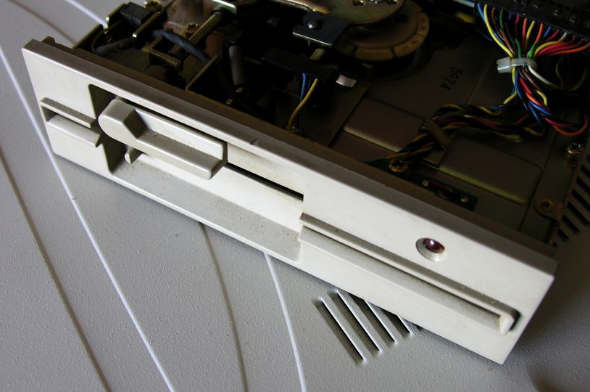Connection to DriversCloud Create a DriversCloud.com account Reset your DriversCloud.com password Account migration
5.25" floppy disks still work under Windows 11
Perfectly compatible with a 5.25" floppy drive straight from the 80s, Windows 11 shows that it is versatile!
As modern as it is, Microsoft's latest operating system has to keep a certain compatibility with past hardware. This backward compatibility is the basis of much of the success of Microsoft's OSes. In the case of Windows 11, most of the peripherals of the last twenty years are perfectly recognized as long as it is possible to physically connect them to the machine and find a functional manufacturer driver. Microsoft has certainly developed a lot of generic drivers, but some very specific products need the driver to be updated for Windows 11, which is far from being systematic.
We are thinking here, for example, of video solutions such as TV tuner cards or capture cards that worked very well under Windows 7, but are not recognized by Windows 10 and, a fortiori, Windows 11. While even optical drives are becoming increasingly rare on modern computers, floppy drives seem to be a relic of the past, almost a prehistoric relic. However, Windows 11 has everything you need to use them! Better still, we're not just talking about 3.5-inch floppy drives, the last ones to be used on PCs: we're also talking about the huge 5.25-inch drives and their floppy disks, which is where the term floppy disk comes from to describe them.
In a video available on his Youtube channel, a certain Jrcraft set out to make one of these antiques work on a machine on which Windows 11 had previously been installed. He explains that he had to find a floppy cable with the famous edge port and its 34 connectors, which is essential for connecting the 5.25-inch drive. He also explains that he used a Gigabyte GA-MA7GPM-DS2H Rev-1 motherboard and an AMD Athlon 64 X2+ Black Edition processor. The other components were of little importance to the success of his venture, according to him.
The video speaks for itself and once the connections were made, Jrcraft didn't need to modify, adjust or set up anything, he says that everything works " out of the box ", in other words right out of the box. We'll let you take a look at his video in which he presents his installation before booting up the machine and loading - rather very slowly - a JPEG image stored on the 5.25" floppy disk. Remember that the latter only had a maximum capacity of 1.2 MB.
A little anecdote to finish: if your system disk - the one on which Windows is located - is called 'C:', it is because historically, PCs have always reserved the first two letters of the alphabet ('A:' and 'B:') for floppy disk drives which were, originally, the only ones available on a computer.





